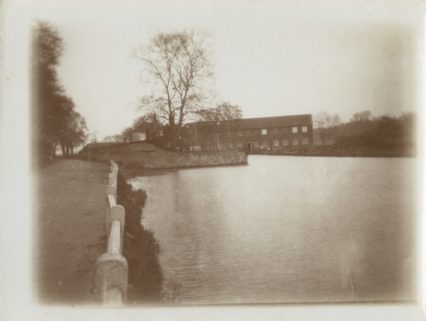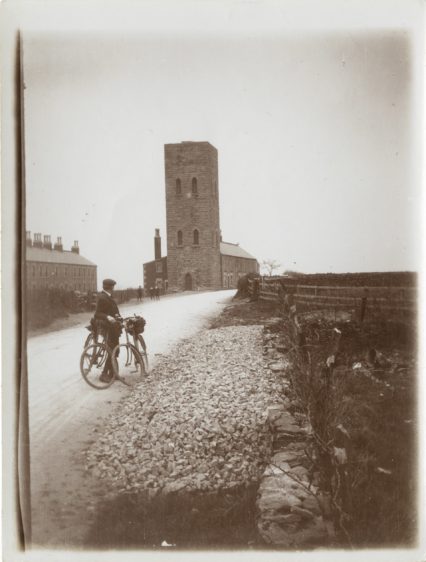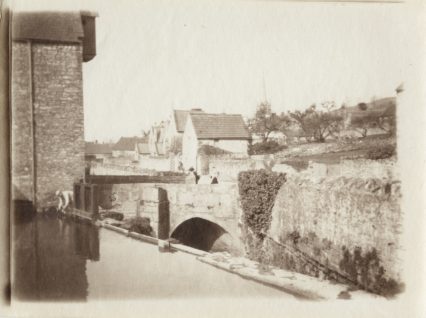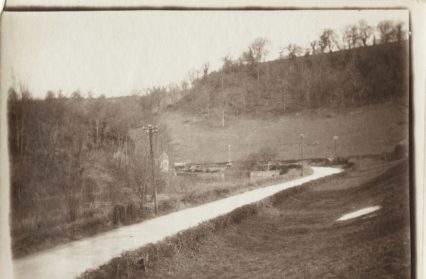In Pursuit of Spring by Edward Thomas is reviewed by Novelist and photographer Jo Mazelis upon a reissue of the book after a century.
Over a hundred years since its first release, Cardiff University’s archive has come together with Little Toller to publish the words and photographs of Edward Thomas, in what is a sumptuous snapshot of a world long gone.
Like all good stories this one begins with the unearthing of long buried treasure, in this instance the recent discovery of the photographs Edward Thomas took on his long ago journey through Southern England, while he was writing In Pursuit of Spring. The reissue of that book, first published in 1914, with the addition of these photos confirms Thomas’ place as a Romantic proto-modernist.
The Edward Thomas of 1913 was not yet a poet, but here in his prose and photographs are the markers for the poems he would later produce. ‘Adlestrop’ comes immediately to mind, that quiet poem of a quiet moment in a quiet railway station that, like a photograph, fixes in time a world which, all too soon, will be torn apart.
 The prose of In Pursuit of Spring is almost hallucinatory, reminiscent at times of Virginia Woolf’s The Waves which is to say it is rich in description, engorged with detail and colour. The words while clear enough have a slightly alien richness and it is easy to imagine Thomas hurrying to make the words on the page before the sensation passed into distorting memory. He had written similar books, for example The Icknield Way which gave specific details of his route. The journey in this book, from London to Somerset, was taken on foot and by bicycle. Like those other walkers, Laurie Lee (As I Walked Out One Midsummer Morning) who walked to Spain and the painter Gwen John who intended to walk through France to Rome, but never get there, it seems astonishing that a person can just set off on foot hardly encumbered by a single thing except perhaps a comb, a single change of clothes, a notebook, pencil and knife. It shouldn’t be so surprising but it is – maybe this is because our modern world is too restricting in terms of dual carriageways and fences and no cheap hotels and a lack of easy acceptance of other people and no trust. Besides which walking and bicycling have become sports or hobbies rather than the cheapest way of travelling from a to b.
The prose of In Pursuit of Spring is almost hallucinatory, reminiscent at times of Virginia Woolf’s The Waves which is to say it is rich in description, engorged with detail and colour. The words while clear enough have a slightly alien richness and it is easy to imagine Thomas hurrying to make the words on the page before the sensation passed into distorting memory. He had written similar books, for example The Icknield Way which gave specific details of his route. The journey in this book, from London to Somerset, was taken on foot and by bicycle. Like those other walkers, Laurie Lee (As I Walked Out One Midsummer Morning) who walked to Spain and the painter Gwen John who intended to walk through France to Rome, but never get there, it seems astonishing that a person can just set off on foot hardly encumbered by a single thing except perhaps a comb, a single change of clothes, a notebook, pencil and knife. It shouldn’t be so surprising but it is – maybe this is because our modern world is too restricting in terms of dual carriageways and fences and no cheap hotels and a lack of easy acceptance of other people and no trust. Besides which walking and bicycling have become sports or hobbies rather than the cheapest way of travelling from a to b.
Looking at the pictures in the new edition of In Pursuit of Spring and also at those in Matthew Hollis’s biography of Edward Thomas’s later years, Now All Roads Lead to France, I find myself wondering, in a strange dreamy way, what does it mean to be that man, not quite Welsh and not quite English. Not quite a poet yet either. Thomas had a ‘passion for Wales’ but loved the countryside of the Home Counties too. The book begins in London with its bustling thoroughfares, where ‘In the streets, for the present, the roar continued of the inhuman masses, amidst which a child’s crying for a toy was an impertinence, a terrible pretty interruption of the violent moving swoon.’ What was England like then? England with its fixed states of being, its morality, its rigid class system. Better or worse? Perhaps it was better because you might know the meaning and value of everything?
 In a sense this aim to discover everything might have been Thomas’s aim too: to know places, to see church spires and dilapidated barns, to feel the brisk wind upon his cheeks, to see how it reddened the cheeks of others. To hold onto it by recording it in words and pictures.
In a sense this aim to discover everything might have been Thomas’s aim too: to know places, to see church spires and dilapidated barns, to feel the brisk wind upon his cheeks, to see how it reddened the cheeks of others. To hold onto it by recording it in words and pictures.
The photographs in ‘Spring’ are reproduced at a modest size (except for the one on the cover) and on regular paper. There is no information in the book about the original pictures or if these were reproduced from prints or negatives, only that these were among items given to the Archives at Cardiff University by Edward Thomas’s daughter Myfanwy, and included ‘manuscripts and typsescript poems … one prose manuscript, his school reports, nine notebooks containing press cuttings, flowers pressings and fragments of prose’ and over 500 photographs, ‘seventeen negatives and two daguerreotypes’.
I have in the past collected old photographs, some in albums lovingly and carefully put together by unknown hands. The places and people they show have come adrift for any source of identification. The prints are often small, no bigger than 2 by 3 inches sometimes. Like Thomas’s photographs they often depict pastoral scenes; lanes and roads, as Thomas’s great friend Robert Frost put it, ‘less travelled’. When they show people it is often an occasion and people are at their best, dressed in Sunday clothes or outfits for a holiday. They pose for the camera, smile into the lens, gather into tight groups to fit into the narrow frame of the photograph.
Like Thomas, the photographers stopped at a particular moment, arrested by the beauty of a dusty path surrounded on both sides by tall hedgerows, under a deep blue sky, the air perfumed by wild flowers, while bees buzz and cuckoos call and birds flit or soar. They press the shutter to fix this moment forever, but something falls away; sounds, scents, the warmth of the sun, the azure sky, the glossy green leaves, the rainbow colours of butterflies and flowers and birds, the russet colour of a fox, the red squirrel, the bright lichen. All is reduced to black and white, or a variety of greys, and so a person a hundred years later may find themselves looking at an undistinguished lane, an anonymous house, an unremarkable pond.
Curiously, looking at Thomas’s photographs reminded me of a photography book called The Pond. Photography as art has repeatedly taken curious steps in its development; away from the well composed image, the pictorial, away from the ‘important subject’ to odd, banal, almost subjectless subjects that are taken in a flatish light and ‘badly’ with either human subjects standing in stiff artificial poses or with the camera at a slant so the horizon and other objects are made tipsy. The Pond by John Gossage is a case in point as this book, a monograph published by the Aperture Foundation consists of fifty-two black and white photographs which show a very ordinary pond and very ordinary mud tracks and some detritus in or near or around some very ordinary trees and distant buildings. In the introduction to the second edition of The Pond Toby Jurovics says succinctly, ‘We were left to wonder, “Why did he make this picture?”’
 The same is true of many of Thomas’s photographs, except he was not a photographer in the same way. Looking at the forty images in this new edition of In Pursuit of Spring the same question comes to mind, ‘Why did he take this picture?’ Perhaps it’s an unnecessary enquiry; for Thomas’s primary record of his journey was created in words. There in the text he fills in all those elements that are missing from the photographs, those effects of the natural world that register and resonate to all the senses; the colour and sound, the taste, the smell and touch. This is why his writing is so dense with description; this was why in a world without easily delivered still and moving pictures, with only fairly primitive sound recording, the written word was uniquely the carrier the majority of meaning. It might be argued that by now, with so much technology available, the written word especially when it is describing the natural world, should have become entirely superfluous and yet one of the best selling books of recent years was Helen Macdonald’s prize-winning, H is for Hawk.
The same is true of many of Thomas’s photographs, except he was not a photographer in the same way. Looking at the forty images in this new edition of In Pursuit of Spring the same question comes to mind, ‘Why did he take this picture?’ Perhaps it’s an unnecessary enquiry; for Thomas’s primary record of his journey was created in words. There in the text he fills in all those elements that are missing from the photographs, those effects of the natural world that register and resonate to all the senses; the colour and sound, the taste, the smell and touch. This is why his writing is so dense with description; this was why in a world without easily delivered still and moving pictures, with only fairly primitive sound recording, the written word was uniquely the carrier the majority of meaning. It might be argued that by now, with so much technology available, the written word especially when it is describing the natural world, should have become entirely superfluous and yet one of the best selling books of recent years was Helen Macdonald’s prize-winning, H is for Hawk.
It is hard to approach this republished book with its achingly hopeful and poignant title without sensing so much darkness to come. The First World War and Edward Thomas’s death seem to constrict and contract even the most blithe of his descriptions of nature, the printed text on the page becoming lines of barbed wire. I found myself consulting two recent biographies of Thomas, Hollis’s and Edward Thomas: From Adlestrop to Arras (2015) by Jean Moorcroft Wilson to get a sense of the man. The most astonishing thing I discovered was that these two books could not agree on the matter of his death. Hollis reported that, ‘Edward Thomas left the dugout behind his post and leaned into the opening to take moment to fill his pipe. A shell passed so close to him that the blast of air stopped his heart. He fell without a mark on his body.’ This seemed as astonishing as it was sad, yet in Moorcroft Wilson’s account: ‘He had … been “killed in the Observation Post by a direct hit through the chest”’. The former account, according to Moorcroft Wilson was the version Thomas’s wife Helen had given, probably based on an understandable mixture of confusion and emotion.
This matters, yet does not matter. In his last days in France Thomas was still watching and listening for birds: ‘Larks singing over No Man’s Land – French mortars’, ‘blackbirds singing far off – a spatter of our machine guns – the spit of one enemy bullet’.
Thomas’s book ends when he is ‘seven and three-quarters to Bridgewater’ where ‘through a low-arched rainbow [he] saw the blueness of the hills of South Wales’. Beside the road he notices bluebells and cowslips; they were not growing there, but (he guesses) dropped by children who had tired of them. ‘I had found Winter’s grave; I had found Spring’ his words falling away, but also suggesting a new beginning and a process of continual renewal.
Images used with kind permission of the Edward Thomas Estate.











